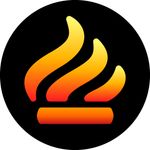Copy link to clipboard
Copied
I am new to Illustrator and am having a great challenge with converting paths to shapes/clipping masks/adding texture to an illustration so that the texture doesn't overflow beyond the boundaries of the design. This is a t-shirt I designed for a non-profit. I thought I knew how to make clipping masks but this situation has me confounded. I want the texture layer confined to the rectangle below and the bit of wing sticking above the rectangle. Obviously, I'm doing something wrong and I have spent hours trying to figure out how to convert the flying hawk (it's comprised of brush stroke paths) to a shape so that I can make a clipping mask. I've tried expanding, outlining, joining, etc. and no matter what I do to it, when I attempt to convert that hawk to a shape in order to make a clipping mask with my texture layer (so that the texture doesn't go beyond the bondaries of the portion of the hawk sticking out above) I get the message that the objects were not converted and I cannot make the clipping mask. Photo attached. I think I may have created this wrong from the get-go because I'm new to Illustrator, but hoping there is a work-around. Thank you in advance for any help! I'm eager to learn what I'm doing wrong so that I am not vexed by this issue again.
 1 Correct answer
1 Correct answer
roselokoum,
First of all, a Clipping Path must be on top of the artwork to be clipped.
With the way you have created the hawk, you may be happier if you work with an Opacity Mask.
You can:
1) Group the paths that form the hawk if not already then hold Ctrl/Cmd and press C and then B to create a copy behind the original;
2) Hide the original hawk from 1) and change all the colours of the copy hawk to white (you can work in the expanded Layer in the Layers panel to hide and make changes);
...Explore related tutorials & articles
Copy link to clipboard
Copied
roselokoum,
First of all, a Clipping Path must be on top of the artwork to be clipped.
With the way you have created the hawk, you may be happier if you work with an Opacity Mask.
You can:
1) Group the paths that form the hawk if not already then hold Ctrl/Cmd and press C and then B to create a copy behind the original;
2) Hide the original hawk from 1) and change all the colours of the copy hawk to white (you can work in the expanded Layer in the Layers panel to hide and make changes);
3) Select both the white copy hawk and the desired artwork (texture/whatever) to clip by it and in the Transparency (flyout) click Make (Opacity) Mask with Clip ticked and Invert Mask unticked.
4) Show the original hawk from 1).
This ought to give you the original hawk on top of the desired artwork (texture/whatever).
Copy link to clipboard
Copied
I cannot thank you enough. Seriously, this worked perfectly and I am so relieved. Thank you very, very much!
Hope you have a great day! I appreciate your wisdom!
Copy link to clipboard
Copied
You are welcome, Rose(?, I thought it might be, otherwise roselokoum).
And thank you for your kind words.
Copy link to clipboard
Copied
Copy link to clipboard
Copied
Thank you very much for sharing the significant subtlety, Lala.
Get ready! An upgraded Adobe Community experience is coming in January.
Learn more